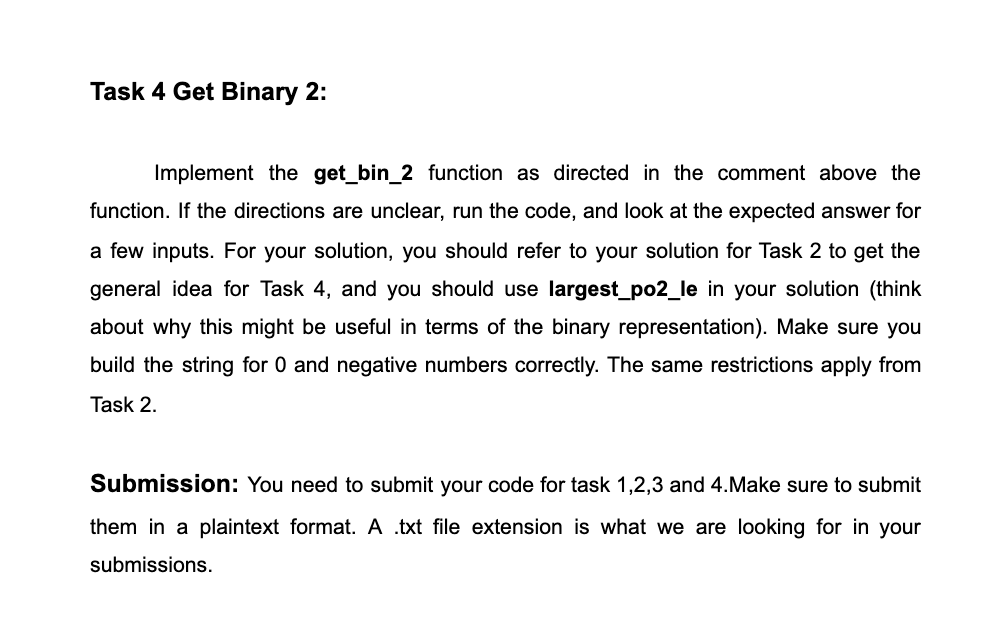Task 4 Get Binary 2: Implement the get_bin_2 function as directed in the comment above the function. If the directions are unclear, run the code, and look at the expected answer for a few inputs. For your solution, you should refer to your solution for Task 2 to get the general idea for Task 4, and you should use largest_po2_le in your solution (think about why this might be useful in terms of the binary representation). Make sure you build the string for 0 and negative numbers correctly. The same restrictions apply from Task 2. Submission: You need to submit your code for task 1,2,3 and 4.Make sure to submit them in a plaintext format. A .txt file extension is what we are looking for in your submissions.
C PROGRAMMING.
#include <stdio.h>
#include <stdbool.h>
#include <stdlib.h>
// BEGIN STRINGBUILDER IMPLEMENTATION
// This code is a very rudimentary stringbuilder-like implementation
// To create a new stringbuilder, use the following line of code
//
// stringbuilder sb = new_sb();
//
// If you want to append a character to the stringbuilder, use the
// following line of code. Replace whatever character you want to
// append where the 'a' is.
//
// sb_append_char(sb, 'a');
//
// Though there are some other functions that might be useful to you,
// the driver code provided uses the functions, so there is no need
// to use them manually.
typedef struct {
char** cars;
size_t* len;
size_t* alloc_size;
} stringbuilder;
stringbuilder new_sb() {
stringbuilder sb;
sb.cars = malloc(sizeof(char*));
*sb.cars = malloc(8*sizeof(char));
(*sb.cars)[0] = 0;
sb.len = malloc(sizeof(size_t));
*sb.len = 0;
sb.alloc_size = malloc(sizeof(size_t));
*sb.alloc_size = 8;
return sb;
}
void sb_append(stringbuilder sb, char a) {
int len = *sb.len;
if (len >= (*sb.alloc_size)-1) {
*sb.alloc_size = (*sb.alloc_size)*2;
char* newcars = malloc((*sb.alloc_size)*sizeof(char));
for (int i = 0; i < *sb.len; i++) {
newcars[i] = (*sb.cars)[i];
}
free(*sb.cars);
(*sb.cars) = newcars;
}
(*sb.cars)[len] = a;
len++;
(*sb.cars)[len] = 0;
*sb.len = len;
}
void delete_sb(stringbuilder sb) {
free(*sb.cars);
free(sb.cars);
free(sb.len);
free(sb.alloc_size);
}
bool sb_is_equal(stringbuilder sb1, stringbuilder sb2) {
if (*sb1.len != *sb2.len)
return false;
for (int i = 0; i < *sb1.len; i++) {
if ((*sb1.cars)[i] != (*sb2.cars)[i])
return false;
}
return true;
}
void print_sb(const stringbuilder sb) {
printf("%s", *sb.cars);
}
// END STRINGBUILDER IMPLEMENTATION
// ============================================================
// Write your solutions to the tasks below
const unsigned UNS_MAX = -1; // 1111...
const unsigned UNS_MIN = 0; // 0000...
const int INT_MAX = UNS_MAX >> 1; // 0111...
const int INT_MIN = ~INT_MAX; // 1000...
// Task 1
// For this function, you must return an integer holding the value
// x+1, however you may not use any constants or the symbol '+'
// anywhere in your solution. This means that
//
// return x - (-1);
//
// is not a valid soltion, because it uses the constant -1.
//
// Hint: Consider what internally happens when you do -x.
int plus_one(int x) {
return x;
}
// Task 2
// For this function, you must build a string that when printed,
// will output the entire binary representation of the integer x,
// no matter how many bits an integer is. You may NOT use
// division (/) or mod (%) anywhere in your code, and should
// instead rely on bitwise operations to read the underlying binary
// representation of x.
stringbuilder get_bin_1(int x) {
stringbuilder sb = new_sb();
sb_append(sb, '$');
return sb;
}
// Task 3
// For this function, you must return the largest power of 2 that
// is less than or equal to x (which will be positive). You may
// not use multiplication or some sort of power function to do this,
// and should instead rely on bitwise operations and the underlying
// binary representation of x. If x is 0, then you should return 0.
unsigned largest_po2_le(unsigned x) {
return x;
}
// Task 4
// For this function, you must build a string that when printed,
// will output the binary representation of the integer x without
// leading zeroes, using a similar method as you did above. If x
// is negative, then the string should start with '-' and be
// followed by the binary for the positive version of the number.
// So if x is -5, then the string should be '-101', and
// if x is 9, then the string should be '1001'. The same
// restrictions from Task 2 apply.
//
// Hint: It may be useful to use the function from Task 3, and
// borrow concepts from Task 2.
stringbuilder get_bin_2(int x) {
stringbuilder sb = new_sb();
sb_append(sb, '$');
return sb;
}

Trending now
This is a popular solution!
Step by step
Solved in 2 steps with 1 images









